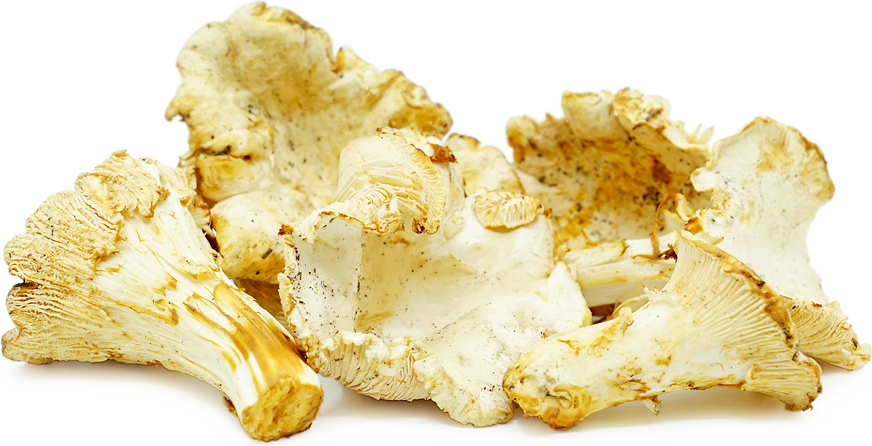


White Chanterelle Mushrooms
Estimated Inventory, lb : 0
Description/Taste
White chanterelle mushrooms are small to medium in size, averaging 5-10 centimeters in diameter and 2-5 centimeters in length, and are irregularly convex in shape. The cream-colored to ivory cap is flat, semi-smooth to scaly, is somewhat funnel-shaped, and has wavy edges with some yellow-orange bruising or discoloration as it matures. Underneath the cap, there are many false gills that look like wrinkles or folds that connect down into the thick, tapering stem. The matching cream-colored stem is solid and also experiences the yellow discoloration when bruised or damaged. White chanterelles have a sweet aroma that is less fruity than the golden chanterelle, and when cooked, they have a mild, earthy flavor with a chewy texture.
Seasons/Availability
White chanterelle mushrooms are available during the fall through mid-winter.
Current Facts
White chanterelle mushrooms, botanically classified as Cantharellus subalbidus, are a wild variety of chanterelle mushrooms that belong to the Cantharellaceae family. Growing in clusters in low-land, old forest areas at the base of trees such as the madrone, pine, hemlock, and fir, White chanterelle mushrooms are found in the Pacific Northwest of the United States and are only harvested from the wild as cultivation cannot reproduce the natural flavors that arise from wild growth. White chanterelle mushrooms are dense, hold their shape well, and are favored by chefs for their mild, earthy taste, scarcity, and versatility to be incorporated into a variety of culinary dishes.
Nutritional Value
White chanterelle mushrooms contain vitamin A, potassium, iron, and essential amino acids.
Applications
White chanterelle mushrooms are best suited for cooked applications such as boiling and sautéing. Before cooking, run the mushrooms under water and brush debris gently from the folds and the caps, allowing them to dry on a paper towel. Once clean, White chanterelle mushrooms can be sautéed in oil or butter with herbs and served as a stand-alone dish or chopped and added to pasta and meat dishes. They can also be dried or cooked and frozen for extended use. When dried, the mushrooms become leathery and need to be rehydrated before cooking. White chanterelle mushrooms pair well with meats such as chicken, veal, bacon, or beef, shallots, garlic, onion, white wine, cognac, port, chicken stock, and heavy cream. They will keep well up to a week when stored unwashed in a brown paper bag in the refrigerator.
Ethnic/Cultural Info
It is believed that White chanterelle mushrooms need specific biological, physical, and chemical characteristics of old growth forests in order to thrive. Old growth forests are classified by their age and are typically hundreds of years old. Mycologists believe that White chanterelle mushrooms fruit in very limiting numbers for this reason as old growth forests are difficult to find due to deforestation and are isolated to specific geographical regions.
Geography/History
White chanterelle mushrooms are native to the coniferous and hardwood forests of northern California and the Pacific Northwest and have been growing wild since ancient times. Today White chanterelle mushrooms grow in limited numbers, amongst the twigs and brambles, and are found at farmers markets and specialty grocers in the United States.
Recipe Ideas
Recipes that include White Chanterelle Mushrooms. One
| Forager Chef |
|
White Chanterelles Roasted with Thyme |
| Salt and Pepper Skillet |
|
Roasted Chanterelle & Yellow Wax Bean Salad |
Podcast




